| La Viga's Walk | |
|---|---|
 | |
| Artist | Pedro Villegas |
| Year | 1706 |
La Viga's walk (Paseo de la Viga in Spanish) is an oil painting. It was made by Pedro Villegas in 1706 and it is the oldest representation of "La Viga", a Mexico City roadway. [1]
| La Viga's Walk | |
|---|---|
 | |
| Artist | Pedro Villegas |
| Year | 1706 |
La Viga's walk (Paseo de la Viga in Spanish) is an oil painting. It was made by Pedro Villegas in 1706 and it is the oldest representation of "La Viga", a Mexico City roadway. [1]
The roadway "La Viga" was the walk used by the merchants who walked from Chalco and Xochimilco, to then sell their products in the city. The painting shows the arrival of New Spain's viceroy, Francisco Fernández de la Cueva and his wife Juana de la Cerda. [2] They are represented in a boat and they come along with two women. Their social position is emphasized by a cloth structure that covers the couple.
The picture also represents the everyday life of the place: the merchants, the trajineras (Mexican boat), chinampas, guardians, the church, people walking around the place and the volcanos Popocatepetl e Iztaccihuatl. [3]
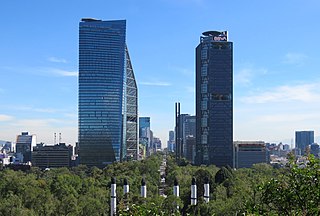
Paseo de la Reforma is a wide avenue that runs diagonally across the heart of Mexico City. It was designed at the behest of Emperor Maximilian by Ferdinand von Rosenzweig during the era of the Second Mexican Empire and modeled after the great boulevards of Europe, such as the Ringstraße in Vienna and the Champs-Élysées in Paris. The planned grand avenue was to link the National Palace with the imperial residence, Chapultepec Castle, which was then on the southwestern edge of town. The project was originally named Paseo de la Emperatriz in honor of Maximilian's consort Empress Carlota. After the fall of the Empire and Maximilian's subsequent execution, the Restored Republic renamed the Paseo in honor of the La Reforma.
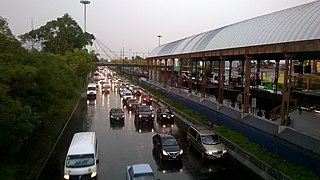
Iztacalco is a borough in Mexico City. It is located in the central-eastern area and it is the smallest of the city's boroughs. The area's history began in 1309 when the island of Iztacalco, in what was Lake Texcoco, was settled in 1309 by the Mexica who would later found Tenochtitlan, according to the Codex Xolotl. The island community would remain small and isolated through the colonial period, but drainage projects in the Valley of Mexico dried up the lake around it. The area was transformed into a maze of small communities, artificial islands called chinampas and solid farmland divided by canals up until the first half of the 20th century. Politically, the area has been reorganized several times, being first incorporated in 1862 and the modern borough coming into existence in 1929. Today, all of the canals and farmland are dried out and urbanized as the most densely populated borough and the second most industrialized.

Las Vigas de Ramírez is a city in the Mexican state of Veracruz. It serves as the municipal seat for the surrounding municipality of the same name. The city was established by decree on 23 November 1523, named after the teacher Rafael Ramírez Castañeda (1884–1959).
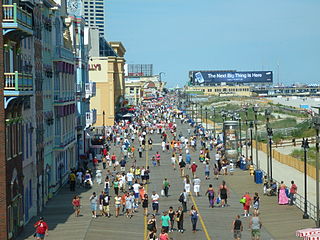
An esplanade or promenade is a long, open, level area, usually next to a river or large body of water, where people may walk. The historical definition of esplanade was a large, open, level area outside fortress or city walls to provide clear fields of fire for the fortress's guns. In modern usage, the space allows the area to be paved as a pedestrian walk; esplanades are often on sea fronts and allow walking whatever the state of the tide, without having to walk on the beach.

A fish market is a marketplace for selling fish and fish products. It can be dedicated to wholesale trade between fishermen and fish merchants, or to the sale of seafood to individual consumers, or to both. Retail fish markets, a type of wet market, often sell street food as well.

La Viga is a station along Line 8 of the metro of Mexico City.
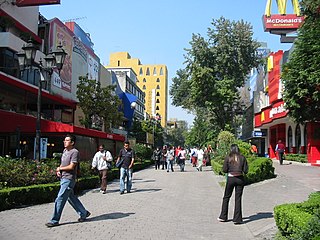
Colonia Juárez is one of the better–known neighborhoods or colonias in the Cuauhtémoc borough of Mexico City. The neighborhood is shaped like a long triangle with the boundaries: Paseo de la Reforma on the north, Avenida Chapultepec on the south, and Eje 1 Poniente on the east.
Colonia Ampliación Asturias is a neighborhood in the Cuauhtémoc borough of Mexico City. It is located southeast of the historic center of Mexico City. It borders are marked by the following streets, to the north Eje Tres Sur or Avenida Calzada del Chabacano, Calzada de la Viga to the east, Calzada de San Antonio Abad to the west and Hernandez Davalos street to the south.

Colonia Cuauhtémoc is a colonia in the Cuauhtémoc municipality of central Mexico City. It is located just north of Paseo de la Reforma, west of the historic center of Mexico City.

The Central de Abasto is Mexico City's main wholesale market for produce and other foodstuffs run similarly to traditional public markets. It was constructed to be the meeting point for producers, wholesalers, retailers and consumers for the entire country. Located in the eastern borough of Iztapalapa, it is the most important commercial establishment in Mexico and the largest of its kind in the world. The market handles over 30,000 tons of merchandise daily, representing 80% of the consumption of the Mexico City metropolitan area. The market was established on former farmland to ease congestion in the historic center of Mexico City.

La Nueva Viga Market is the largest seafood market in Mexico and the second largest in the world after the Toyosu Market in Japan. It is located in Mexico City far inland from the coast, because of historical patterns of commerce in the country. The market handles 1,500 tons of seafood daily, representing about 60% of the total market. Most of the seafood is distributed to the Mexico City metropolitan area and the states surrounding it, but there is distribution to other states and abroad.

Traditional fixed markets in Mexico are multiple-vendor markets permanently housed in a fixed location. They go by a variety of names such as "mercados públicos", "mercados municipales" or even more often simply "mercados" (markets). These markets are distinct from others in that they are almost always housed in buildings owned and operated by the local government, with numerous stands inside rented by individual merchants, who usually sell, produce and other basic food staples. This market developed in Mexico as a way to regulate pre Hispanic markets called tianguis. These tianguis markets remain in Mexico, with the most traditional held on certain days, put up and taken down the same day, much the way it was done in Mesoamerica.

The Jardín del Arte Sullivan is an outdoor art gale which takes place every Sunday near the historic center of Mexico City in a neighborhood called Colonia San Rafael. This gallery began in the 1950s, when young artists who could not show their works in traditional galleries and shows decided to set up in front of their studios and in local parks to exhibit and sell their work. A number began to do so at the base of the Monumento a la Madre at Sullivan Park and in 1959, the Asociación Jardín del Arte, a non profit civil association was established affiliated with the Instituto Nacional de la Juventud Mexicana. Since then the outdoor gallery has shown works by a number of artists who moved on to better things such as Rodolfo Morales, established a second and third art market in the San Ángel neighborhood and has grown to 700 members.

Various types of visual arts developed in the geographical area now known as Mexico. The development of these arts roughly follows the history of Mexico, divided into the prehispanic Mesoamerican era, the colonial period, with the period after Mexican War of Independence, the development Mexican national identity through art in the nineteenth century, and the florescence of modern Mexican art after the Mexican Revolution (1910-1920).
Azteca de Gyves is a Mexican artist from Juchitán de Zaragoza in the state of Oaxaca. She is of Zapotec heritage and one of only two prominent female artists in her city. She has been a member of the Salón de la Plástica Mexicana since 1998 and has exhibited her work individually and collectively in Mexico, Brazil, the United States, Japan and other countries.

Tosia Malamud was a Mexican sculptor of Ukrainian origin, one of the first female graduates of Mexico's Escuela Nacional de Artes Plásticas. Her family immigrated to Mexico when she was four, and her talent for art appeared early. She went to art college against her parents' wishes, graduating in 1943. Because of family obligations, her career did not begin until the mid-1950s with two important exhibitions that brought her style to the attention of critics. From then until her death, she exhibited her work in Mexico and abroad. She also created large and small works for public spaces and was considered to be the best bust maker in Mexico at the time. In addition to depictions of notable people, she created works mostly dealing with maternity, family and childhood which can be found in places such as the Museo de Arte Moderno and the Hospital Siglo XXI in Mexico City. La familia has become iconic for Mexico's Instituto Mexicano de Seguro Social and Viento for the Museo de Arte Contemporáneo in Morelia.

How Doth the Little Crocodile is both a painting and an outdoor bronze sculpture by British-born Mexican surrealist artist Leonora Carrington.

El Ángel de la Seguridad Social is an outdoor 2013 bronze sculpture by Jorge Marín, installed along Mexico City's Paseo de la Reforma, in Mexico. It commemorates the creation of the Mexican Social Security Institute.
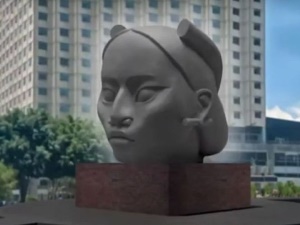
Tlalli was a proposed sculpture of a large indigenous woman's head by contemporary artist Pedro Reyes. It was proposed to replace the Monument to Christopher Columbus along Mexico City's Paseo de la Reforma.

Statues of Tlatoque Ahuitzotl and Itzcoatl are installed in Mexico City. They are collectively known as the Monumento a los Indios Verdes. The statues are verdigris due to the effects of weather. They are around 3 meters (9.8 ft) to 4 meters (13 ft) tall and their plinths have inscriptions in Nahuatl. The statues were created by Alejandro Casarín to represent Mexico at the 1889 Paris Exposition.